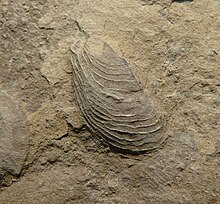Bakevelliidae
| Bakevelliidae Temporal range: Serpukhovian – Bartonian
| |
|---|---|

| |
| fossil | |
| Scientific classification | |
| Kingdom: | Animalia |
| Phylum: | Mollusca |
| Class: | Bivalvia |
| Order: | Pteriida |
| Superfamily: | Pterioidea |
| Family: | †Bakevelliidae King, 1850 |
| Genera | |
|
See text | |
Bakevelliidae is an extinct family of prehistoric bivalves that lived from the Late Mississippian until the Middle Eocene.[1] Bakevelliidae species are found worldwide, excluding Antarctica. Living a stationary life attached to substrate in marine and brackish environments, they formed shells of an aragonite composition with a low amount of magnesium calcite. The family was named by King in 1850. At least one genus in the family, , has a notably twisted commissure join.[2]
Morphology[]
Generally the family consists of species with elongate shells with notably unequal valves. Some of the genera have lost the small anterior auricle but all lack a notch. The shell structuring consists of a regular prismatic calcitic outer layer and an interior layering which is nacreous.[3] The valve surfaces show multiple pits where the valve ligaments were attached. The valve dentition generally consisted of a series of short, transverse teeth along the anterior edge and a few more elongated teeth along the sides.[3] Shells of the included genera range from having radial sculpturing to not having any radial sculpture. Several of the species have an early growth period in which the valve ligament is anchored in a single pit in the shell. When the species size exceeded approximately 6 millimetres (0.24 in) the ligament attachment would develop to encompass two or more pits. One possible species of Bakevelliid from the early Triassic of Utah is tentatively included in the genus but is noted for having an adult shell with only one ligament attachment pit, contrary to the normal state of the rest of the family.[3]
Taxonomy[]
Taxonomy taken from The Paleobiology Database.
Bakevelliidae King, 1850
- Genus Chavan, 1951
- Genus White, 1887
- Genus King, 1848
- Subgenus Bakevellia (Bakevellia) King, 1848
- Subgenus Bakevellia (Boreiobakevellia) Kurushin, 1980
- Subgenus Bakevellia (Maizuria) Nakazawa, 1959
- Subgenus Bakevellia (Neobakevellia) Nakazawa, 1959
- Genus Cassiavellia Tëmkin & Pojeta, Jr., 2010
- Genus Cox, 1948
- Genus
- Genus Cox, 1954
- Genus Gervillaria Cox, 1951
- Genus Waagen, 1907
- Genus Gervillia Defrance, 1820
- Subgenus Gervillia (Cultriopsis) Cossman, 1904
- Subgenus Gervillia (Gervillia) Defrance, 1820
- Genus Whitfield, 1885
- Genus
- Subgenus Hoernesia (Strophopteria) Guo, 1985
- Genus Polubotko, 1992
- Genus Hayami, 1959
- Genus Larghi, 200
- Genus Stephenson, 1953
- Genus (Nakazawa & Newell, 1968)
- Genus Meek, 1873
- Genus Stephenson, 1955
- Genus Nakazawa & Newell, 1968
References[]
- ^ The Paleobiology Database Bakevelliidae entry. Retrieved 2 January 2012.
- ^ Savazzi, E. (1984). "Adaptive significance of shell torsion in mytilid bivalves" (PDF). Palaeontology. 27 (2): 307–314. Archived from the original (PDF) on 25 April 2012. Retrieved 4 January 2012.
- ^ a b c Boyd, D.W.; Newell, N.D. (2002). "A Unique Pterioid Bivalve from the Early Triassic of Utah". American Museum Novitates. 3375: 1–9. doi:10.1206/0003-0082(2002)375<0001:AUPBFT>2.0.CO;2. Retrieved 4 January 2012.
- Bakevelliidae
- Prehistoric bivalve families
- Mississippian first appearances
- Bartonian extinctions